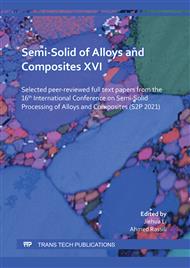[1]
Z. Fan, Semisolid metal processing, Int. Mater. Rev. 47 (2003) 49–85.
Google Scholar
[2]
A. Pola, M. Tocci, P. Kapranos, Microstructure and properties of semi-solid aluminum alloys: A literature review, Metals (Basel). 8 (2018) 181.
DOI: 10.3390/met8030181
Google Scholar
[3]
A.K. Dahle, S. Sannes, D.H. St. John, H. Westengen, Formation of defect bands in high pressure die cast magnesium alloys, J. Light Met. 1 (2001) 99–103.
DOI: 10.1016/s1471-5317(01)00002-5
Google Scholar
[4]
J. Santos, A.E.W. Jarfors, A.K. Dahle, Filling, feeding and defect formation of thick-walled AlSi7Mg0.3 semi-solid castings, Solid State Phenom. 256 (2016) 222–227.
DOI: 10.4028/www.scientific.net/ssp.256.222
Google Scholar
[5]
M. Payandeh, A.E.W. Jarfors, M. Wessén, Influence of Microstructural Inhomogeneity on Fracture Behaviour in SSM-HPDC Al-Si-Cu-Fe Component with Low Si Content, Solid State Phenom. 217–218 (2014) 67–74.
DOI: 10.4028/www.scientific.net/ssp.217-218.67
Google Scholar
[6]
M. Reisi, B. Niroumand, Effects of stirring parameters on rheocast structure of Al-7.1wt.%Si alloy, J. Alloys Compd. 470 (2009) 413–419.
DOI: 10.1016/j.jallcom.2008.02.104
Google Scholar
[7]
B.N. P. Melali, P. Ashtijoo, Effect of stirring speed and flow pattern on the microstructure of a rheocast Al-Mg alloy, Met. Mater. Eng. 21 (2015) 35–43.
DOI: 10.30544/131
Google Scholar
[8]
L. Ratke, A. Sharma, D. Kohli, Effect of process parameters on properties of Al-Si alloys cast by Rapid Slurry Formation (RSF) technique, in: IOP Conf. Ser. Mater. Sci. Eng., (2011).
DOI: 10.1088/1757-899x/27/1/012068
Google Scholar
[9]
H.I. Laukli, C.M. Gourlay, A.K. Dahle, Migration of crystals during the filling of semi-solid castings, Metall. Mater. Trans. A. 36 (2005) 805–818.
DOI: 10.1007/s11661-005-0195-z
Google Scholar
[10]
C.M. Gourlay, A.K. Dahle, Dilatant shear bands in solidifying metals, Nature. 445 (2007) 70–73.
DOI: 10.1038/nature05426
Google Scholar
[11]
M. Wessén, H. Cao, The RSF technology-A possible breakthrough for semi-solid casting processes, Int. Conf. High Tech Die Cast. (2006) 22–28.
Google Scholar
[12]
H.-T. Li, Y. Wang, Z. Fan, Mechanisms of enhanced heterogeneous nucleation during solidification in binary Al–Mg alloys, Acta Mater. 60 (2012) 1528–1537.
DOI: 10.1016/j.actamat.2011.11.044
Google Scholar
[13]
A.K. Dahle, D.H. StJohn, Rheological behaviour of the mushy zone and its effect on the formation of casting defects during solidification, Acta Mater. 47 (1998) 31–41.
DOI: 10.1016/s1359-6454(98)00342-5
Google Scholar
[14]
J. Wang, J. Zhao, Y. Zhang, D. Wang, Y. Li, Y. Song, Analysis of the effect of particle size on permeability in hydrate-bearing porous media using pore network models combined with CT, Fuel. 163 (2016) 34–40.
DOI: 10.1016/j.fuel.2015.09.044
Google Scholar


